Click image for BBB rating
See our Privacy Policy
cool="cool" width="787" height="11198" border="0" cellpadding="0" cellspacing="0" gridx="16" showgridx="showgridx" usegridx="usegridx" gridy="16" showgridy="showgridy" usegridy="usegridy" bgcolor="#99ccff">
|
|
|
 |
|
|
|
|
|
|
|
Welcome to Spaightwood Galleries, Inc.
120 Main Street, Upton MA 01568-6193
|
|
|
|
|
|
|
|
|
|
The Resurrection is the ultimate conclusion to the Passion as a a whole and the event that turns the cowering disciples into the heroic martyrs they will become. For St. Paul, the persecutor of Christians, who was transformed into an Apostle of Christ, risking his life to preach and teach: "the message about the cross is foolishness to those who are perishing, but to us who are being saved it is the power of God. For it is written, 'I will destroy the wisdom of the wise, and the discernment of the discerning I will thwart.' Where is the one who is wise? Where is the scribe? Where is the debater of this age? Has not God made foolish the wisdom of the world? For since, in the wisdom of God, the world did not know God through wisdom, God decided, through the foolishness of our proclamation, to save those who believe. For Jews demand signs and Greeks desire wisdom, but we proclaim Christ crucified, a stumbling block to Jews and foolishness to Gentiles, but to those who are the called, both Jews and Greeks, Christ the power of God and the wisdom of God. For God’s foolishness is wiser than human wisdom, and God’s weakness is stronger than human strength. Consider your own call, brothers and sisters: not many of you were wise by human standards, not many were powerful, not many were of noble birth. But God chose what is foolish in the world to shame the wise; God chose what is weak in the world to shame the strong; God chose what is low and despised in the world, things that are not, to reduce to nothing things that are, so that no one might boast in the presence of God. He is the source of your life in Christ Jesus, who became for us wisdom from God, and righteousness and sanctification and redemption, in order that, as it is written, 'Let the one who boasts, boast in the Lord' " (I Corinthians 1: 18-31). The illogical truth that the Resuurection embodies turned the wise and learned Pharisee that Saul used to be into a fool for Christ: "Do not deceive yourselves. If you think that you are wise in this age, you should become fools so that you may become wise. For the wisdom of this world is foolishness with God. For it is written, 'He catches the wise in their craftiness' " (1 Corinthians 3:18-19). Thanks to Erasmus' Encomium Moriae / The Praise of Folly and, in England, Shakespeare's comedies, especically the ones in which the clowns and fools step forward to show the wise the foolishness of wisdom and the wisdom of folly (an explicit theme in A Midsummer NIght's Dream, As You Like It, and Twelfth Night)." But the wisdom of what St. Paul calls the Folly of the Cross is for him the ultimate truth to which all Christians must witness: "Now if Christ is proclaimed as raised from the dead, how can some of you say there is no resurrection of the dead? If there is no resurrection of the dead, then Christ has not been raised; and if Christ has not been raised, then our proclamation has been in vain and your faith has been in vain. We are even found to be misrepresenting God, because we testified of God that he raised Christ—whom he did not raise if it is true that the dead are not raised. For if the dead are not raised, then Christ has not been raised. Christ has not been raised, your faith is futile and you are still in your sins. Then those also who have died in Christ have perished. If for this life only we have hoped in Christ, we are of all people most to be pitied. But in fact Christ has been raised from the dead, the first fruits of those who have died. For since death came through a human being, the resurrection of the dead has also come through a human being; for as all die in Adam, so all will be made alive in Christ." (I Corinthians 15:12-22).
|
|
|
|
|
|
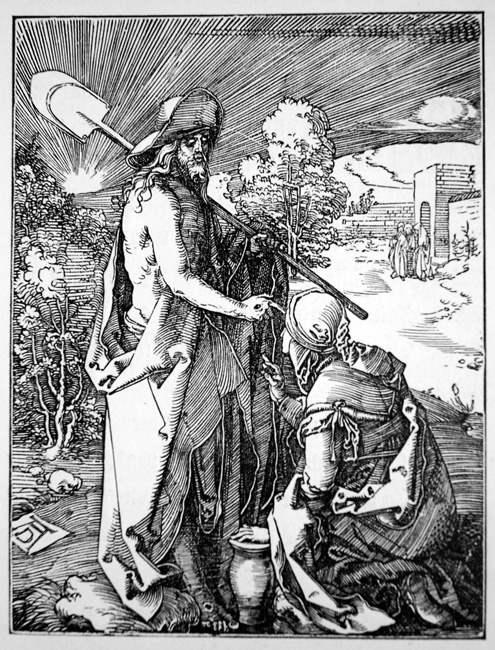 |
|
Albrecht Durer (Nuremburg, 1471-1528), Noli me tangere / Do not touch me (B. 47, S. 131) Original woodcut, c. 1510 for the Small Passion. Strauss suggests that this woodcut shows Dürer's "genius and inventive powers. He has transformed Christ into a gardener. The broad brim of his hat is turned up to reveal his entire face. The shiny blade of the transfigured Christ's shovel reflects the rising 'sun of righteousness' that already brightens the landscape in the background, and is about to encompass the Magdalen. She is tempted to touch him, who is shown here in an unusual way–partially unclad, with an almost effeminate softness, gently turning her away" (Woodcuts, 392). He also notes that the "minimal cross-hatching is in distinct contrast to the technique of the preceding sheet, in wihch Christ appears to his mother." In 1844 plaster casts were made from Durer's original woodblocks for the Small Woodcut Passion, which had just been acquired by the British Museum. From these casts, metal plates were made and a small edition produced. Our impression is from this edition. Image size: 122x95mm. Price: Please call or email for current pricing information.
|
|
|
|
|
|
This scene occurs only in John's Gospel (20: 11-18): "But Mary stood weeping outside the tomb. As she wept, she bent over to look into the tomb; and she saw two angels in white, sitting where the body of Jesus had been lying, one at the head and the other at the feet. They said to her, 'Woman, why are you weeping?' She said to them, 'They have taken away my Lord, and I do not know where they have laid him.' When she had said this, she turned around and saw Jesus standing there, but she did not know that it was Jesus. Jesus said to her, 'Woman, why are you weeping? Whom are you looking for?' Supposing him to be the gardener, she said to him, 'Sir, if you have carried him away, tell me where you have laid him, and I will take him away.' Jesus said to her, 'Mary!' She turned and said to him in Hebrew, 'Rabbouni!' (which means Teacher). Jesus said to her, 'Do not hold on to me, because I have not yet ascended to the Father. But go to my brothers and say to them, ‘I am ascending to my Father and your Father, to my God and your God.’ Mary Magdalene went and announced to the disciples, 'I have seen the Lord'; and she told them that he had said these things to her."
|
|
|
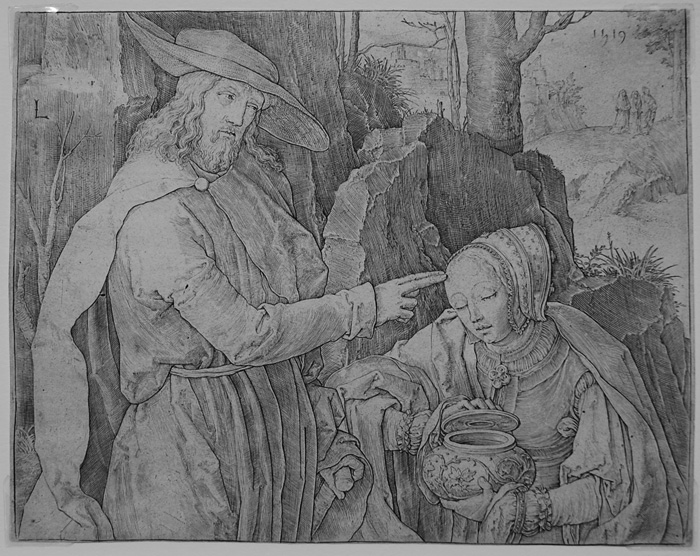 |
|
|
|
Lucas van Leyden (Dutch, 1494-1533), Noli me tangere / Christ appearing to St. Mary Magdalen as a gardener (New Hollstein 77 i/iii, Bartsch 77). Original engraving, 1519. First state (of 3) before the address "M. Petri ex" added in the top right corner; printed on laid paper (small shield with a crowned letter (?) watermark). Trimmed on or within the platemark but outside the black border. A very good well-inked and early impression of this scarce print. Signed in the plate with an L top left and dated 1519 top right. There is a small area above the L where the plate seems to have been scraped, perhaps for revision, suggesting that this may be a proof before the first printing. Christ here appears to be blessing Mary. In the upper rear, we see the three Marys approaching the tomb earlier on Easter morning. Image size135x170mm. Price: Please call or email for current pricing information.
|
|
|
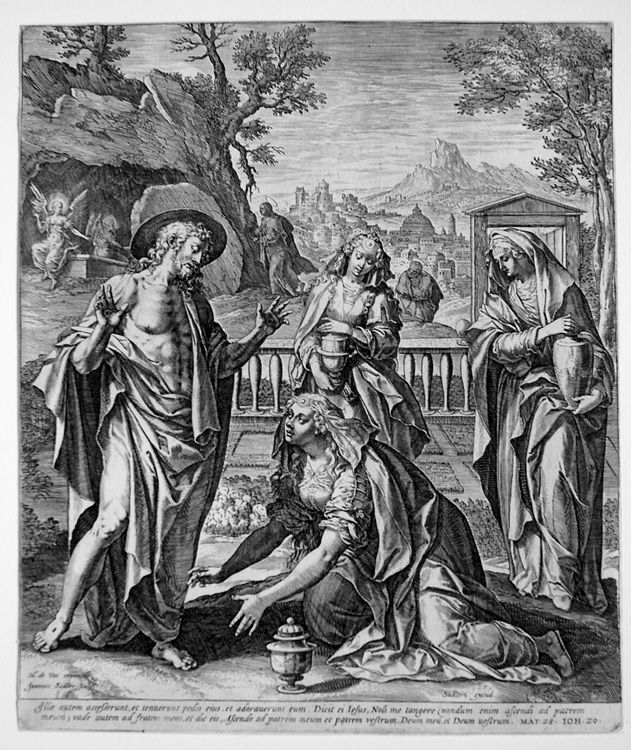 |
|
|
|
Jan Sadeler (Dutch, 1560-1600), Noli me tangere / Christ appearing to St. Mary magdalen as a gardener (Hollstein 257). Engraving after Maarten de Vos, 1582. A very good impression on laid paer engraved and published by Sadeler, one of the leading Antwerp engravers and print publishers until the revolt of the Netherlands against Philip II caused a Spanish army to be stationed in Antwerp and Sadeler and his brother left for less dangerous pastures (like Cologne, Munich, and Venice). Late in his life he founded a print publishing dynasty that lasted for nearly 100 years. Signed in the plate lower left: "M. de vos inuentor / Joannes Sadler scalps." and lower right "Sadleri excud). In the foreground, Mary Magdelen reaches out toward Christ, while the other two Marys with eyes downcast do not appear to see him; in the rear upper left, we see the earlier moment when the two angels by the tomb tell Mary Magdalen that Jesus is not there. Trimmed on or within the platemark but with the borderlines. Image size: 238x200mm. Price: Please call or email for current pricing information.
|
|
|
|
|
|
|
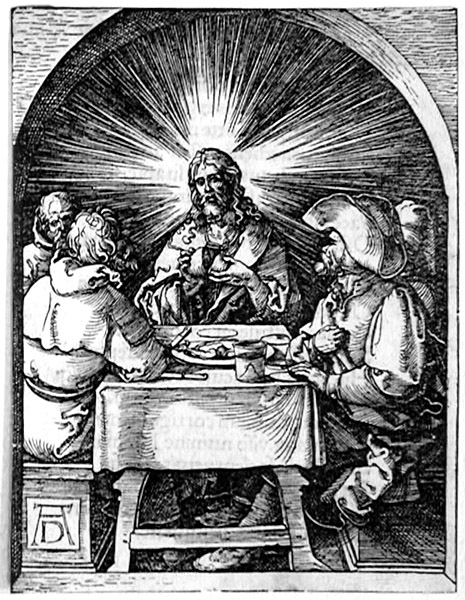 |
|
|
|
Albrecht Durer (Nuremburg, 1471-1528), Christ appears to the disciples at Emmaus (B. 48, S. 132) Original woodcut, c. 1510 for the Small Passion. A beautiful impression from the first Latin edition of 1511, with the Latin text and the stamp of Count de Paar on the verso. Strauss observes that Durer has pictured the "exact moment" when the disciples recognize the newly risen Christ. "An instant later Christ would disappear. The plates are sll empy, food has not been touched, as the disciple on the left fixes his eyes on Jesus, as if hypnotized. The one oppopsite reaches for his chest in a gesture of amazement." A very powerful and dramatic piece. Several small stains under the table and at the top of the image. Image size: 127x96mm. Price: SOLD.
|
|
|
|
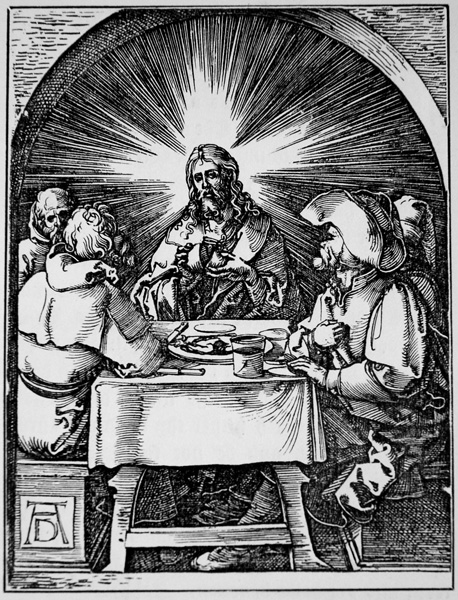 |
|
Albrecht Durer (Nuremburg, 1471-1528), Christ appears to the disciples at Emmaus (B. 48, S. 132) Original woodcut, c. 1510 for the Small Passion. In 1844 plaster casts were made from Durer's original woodblocks for the Small Woodcut Passion, which had just been acquired by the British Museum. From these casts, metal plates were made and a small edition produced. Our impression is from this edition. Strauss observes that Durer has pictured the "exact moment" when the disciples recognize the newly risen Christ. "An instant later Christ would disappear. The plates are sll empy, food has not been touched, as the disciple on the left fixes his eyes on Jesus, as if hypnotized. The one oppopsite reaches for his chest in a gesture of amazement." A very powerful and dramatic piece. Image size: 127x96mm. Price: Please call or email for current pricing information.
|
|
|
|
|
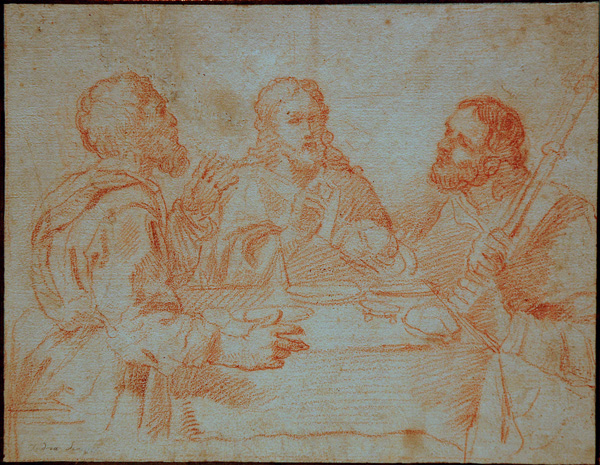 |
|
|
Andrea Schiavone (Zara 1510-1563 Rome), The Supper at Emmaus. Red chalk on tan laid paper mounted on laid paper. According to the Grove Dictionary of Art, Schiavone (also known as Andrea Meldolla) was born in Zara in Dalmatia and trained either in Zara or in Venice. He worked in fresco, panel painting, and etching (teaching himself to etch by working initially from drawings by Parmigianino). By 1540, he was well enough established in Venice that Vasari commissioned a large battle picture (which he mentions in his Lives). Although initially much influenced by Parmigianino and Central Italian Mannerism, "he was also a strikingly daring exponent of Venetian painterly techniques," and ultimately combined both in his works, influencing Titian, Tintoretto, and Bassano among others. His works "shocked some contemporaries and stimulated others." By the 1550s, he had achieved a new synthesis of Raphael and Titian's compositional elements with his own interest in atmosphere, effecting a "fusion of form with a dense atmosphere in a pictorial fabric whose elements tend to lose their separate indenties" (Francis E, Richardson, in the Encyclopedia of Italian Renaissance & Mannerist Art, 2: pp. 1502-04 at 1503). Richardson also insists on his importance as an etcher: "In etching he was similarly innovative. his technique was unlike that of any contemporary: unsystematically he used dense webs of light, fine, multidirectional hatching to create a tonal continuum embracing form, light, shadow, and air. His etchings are the only real equivalent in printmaking of later 16th-century Venetian painterly modes, and his technical experiments were emulated by 17th-century etchers such as Jacques Bellange, Giovanni Benedetto Castiglione, and Rembrandt" (2: 1503-04).The drawing illustrates the verses in the Gospel of Luke that describe the happenings of Easter Sunday: "And, behold, two of them went that same day to a village called Emmaus, which was from Jerusalem about threescore furlongs. And they talked together of all these things which had happened. And it came to pass, that, while they communed together and reasoned, Jesus himself drew near, and went with them. But their eyes were holden that they should not know him. And he said unto them, 'What manner of communications are these that ye have one to another, as ye walk, and are sad?' And the one of them, whose name was Cleopas, answering said unto him, 'Art thou only a stranger in Jerusalem, and hast not known the things which are come to pass there in these days?' And he said unto them, 'What things?' And they said unto him, 'Concerning Jesus of Nazareth, which was a prophet mighty in deed and word before God and all the people: And how the chief priests and our rulers delivered him to be condemned to death, and have crucified him. But we trusted that it had been he which should have redeemed Israel: and beside all this, today is the third day since these things were done. Yea, and certain women also of our company made us astonished, which were early at the sepulchre; And when they found not his body, they came, saying, that they had also seen a vision of angels, which said that he was alive. And certain of them which were with us went to the sepulchre, and found it even so as the women had said: but him they saw not.' Then he said unto them, 'O fools, and slow of heart to believe all that the prophets have spoken: Ought not Christ to have suffered these things, and to enter into his glory?' And beginning at Moses and all the prophets, he expounded unto them in all the scriptures the things concerning himself. And they drew nigh unto the village, whither they went: and he made as though he would have gone further. But they constrained him, saying, Abide with us: for it is toward evening, and the day is far spent. And he went in to tarry with them. And it came to pass, as he sat at meat with them, he took bread, and blessed it, and brake, and gave to them. And their eyes were opened, and they knew him; and he vanished out of their sight. And they said one to another, 'Did not our heart burn within us, while he talked with us by the way, and while he opened to us the scriptures?' And they rose up the same hour, and returned to Jerusalem, and found the eleven gathered together, and them that were with them, Saying, 'The Lord is risen indeed, and hath appeared to Simon.' And they told what things were done in the way, and how he was known of them in breaking of bread. And as they thus spake, Jesus himself stood in the midst of them, and saith unto them, 'Peace be unto you' " (Luke 24:13-36). Attributed to Schiavone in an early italic hand lower left recto and on the verso at the top of the backing sheet, which also gives an old collector's catalogue number. Image size: 201x264mm Price: Please call or email for current pricing information.
|
|
|
|
|
|
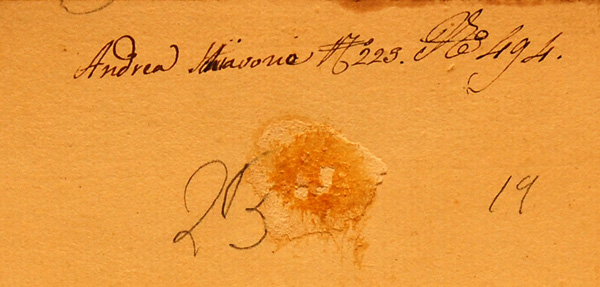 |
|
|
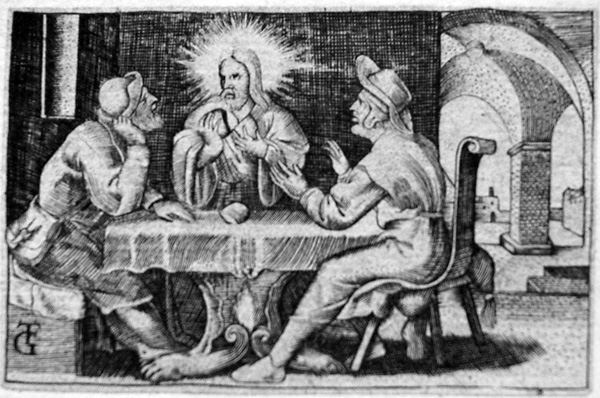 |
|
|
|
Master GF (German, mid-16th century). The Supper at Emmaus. Engraving after Georg Pencz. A very good impression on laid paper trimmed on or within the platemark. Image size: 40x59mm. Price: Please call or email for current pricing information.
|
|
|
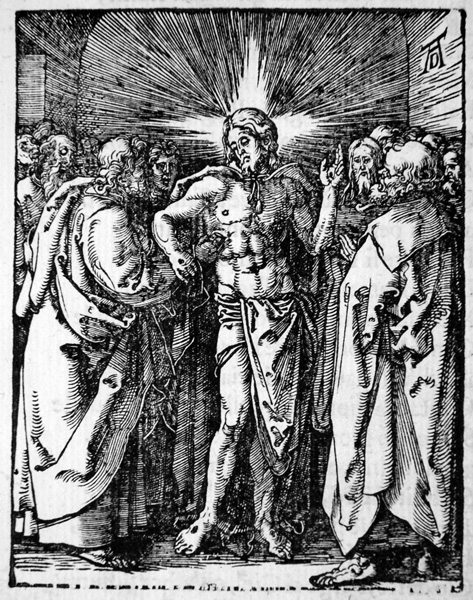 |
|
Albrecht Durer (Nuremburg, 1471-1528), Christ appears to Thomas (B. 49, S. 133, Meder 158) Original woodcut, c. 1510 for the Small Passion. Our impression is from the Italian edition of 1612 with the Italian text on the verso. The bottom border has a great many breaks in it; Meder calls fot a big gap in the upper right corner. Someone has "fixed" our impression by suplying what is missing in pen. The text underlying this print is John 20: 24-29: "But Thomas (who was called the Twin), one of the twelve, was not with them when Jesus came. So the other disciples told him, 'We have seen the Lord.' But he said to them, 'Unless I see the mark of the nails in his hands, and put my finger in the mark of the nails and my hand in his side, I will not believe.' A week later his disciples were again in the house, and Thomas was with them. Although the doors were shut, Jesus came and stood among them and said, 'Peace be with you.' Then he said to Thomas, 'Put your finger here and see my hands. Reach out your hand and put it in my side. Do not doubt but believe.' Thomas answered him, 'My Lord and my God!' Jesus said to him, 'Have you believed because you have seen me? Blessed are those who have not seen and yet have come to believe.' " Large margins; Signed with the monogram top right; the sheet is marked k 2 in the margin below the woodcut. On the reverse, there is a page of Italian text with the heading ASCENSIONE and lower left a small collector's stamp in red. Old paper hinges at top.Image size: 125x97mm. Price: Please call or email for current pricing information.
|
|
|
|
|
|
|
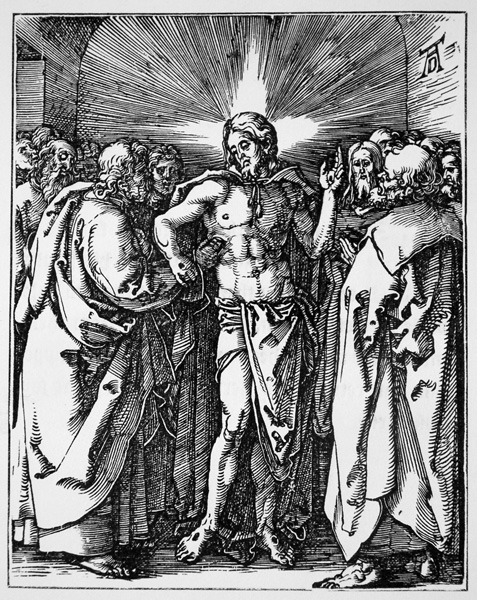 |
|
Albrecht Durer (Nuremburg, 1471-1528), Christ appears to Thomas (B. 49, S. 133, Meder 158) Original woodcut, c. 1510 for the Small Passion. In 1844 plaster casts were made from Durer's original woodblocks for the Small Woodcut Passion, which had just been acquired by the British Museum. From these casts, metal plates were made and a small edition produced. Our impression is from this edition. Image size: 125x97mm. Price: Please call or email for current pricing information.
|
|
|
|
|
|
|
|
|
|
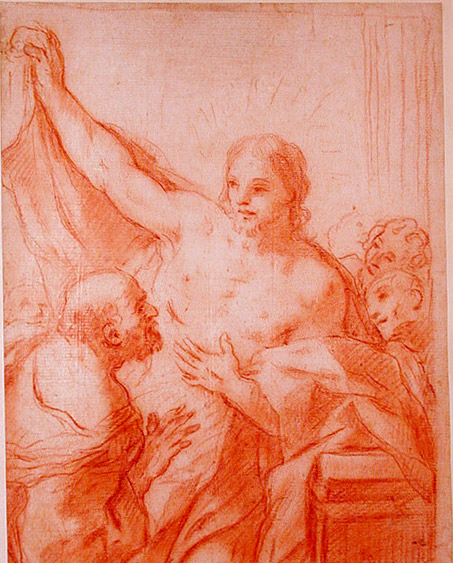 |
|
Guercino (Giovanni Francesco Barbieri, 1591-1666), attributed, Doubting Thomas. Red chalk drawing on laid paper with no watermark. Stamped with the collector's mark of J. Auldjo (Lugt 48). A previous owner has noted "Guercino" as the author of this drawing, in which St. Peter watches as St. Thomas reaches around from the right to insert his left hand into the wound in Christ's side at Jesus' command so that he might not perish through his unbelief. Giovanni Francesco Barberi was nicknamed Guercino because he was guercio, or cross-eyed. Born in poverty in Cento, near Ferrara, he was largely self-taught, though he also served an apprenticeship. The glowing colorism and emotion of Lodovico Carracci's Holy Family with Saint Francis in Bologna influenced him profoundly, and Lodovico himself encouraged the young man. From 1614 to 1621, the year Pope Gregory XV summoned him to Rome, Guercino painted the altarpieces that are his most Baroque creations. With Lodovico's and Caravaggio's works pointing the way, Guercino brought the viewer into the painting's space, adding dramatic lights and darks and greater emotional intensity. Throughout his career, Guercino's style underwent dramatic changes. In Rome he first felt pressured to paint in the popular classicizing style. Returning to Cento two years later, his dark shadows faded, strong movement disappeared, and details emerged distinctly in clear light. To "satisfy as well as he could most of the people, especially those who asked for paintings and had the money to pay for them, he had shown paintings in the lighter style," reported his first biographer. Guercino ran his Cento studio until 1642, when Guido Reni, who had loathed him, died. Guercino then moved to Bologna, taking over Reni's religious picture workshop and his role as the city's leading painter.Image size: 264x204mm. Price: NFS.
Recently, one of Guercino's drawings sold at auction for well over Please call or email for current pricing information. For the time being, this drawing is not for sale.
|
|
|
|
|
|
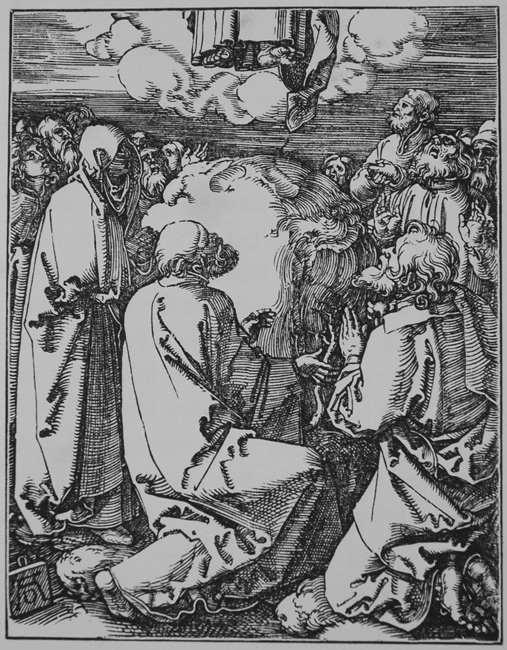 |
|
Albrecht Durer (Nuremburg, 1471-1528), The Ascension (B. 50, S. 134, Meder 159). Original woodcut, c. 1510 for the Small Passion. As the Virgin Mary and the Apostles watch, Jesus rises effortlessly out of the image area, allowing us to see only the soles of his feet and the bottom of his clothes. In 1844 plaster casts were made from Durer's original woodblocks for the Small Woodcut Passion, which had just been acquired by the British Museum. From these casts, metal plates were made and a small edition produced. Our impression is from this edition. Image size: 125x97mm. Price: Please call or email for current pricing information.
|
|
|
|
|
|
'After his suffering he presented himself alive to them by many convincing proofs, appearing to them during forty days and speaking about the kingdom of God. While staying with them, he ordered them not to leave Jerusalem, but to wait there for the promise of the Father. 'This,' he said, 'is what you have heard from me; for John baptized with water, but you will be baptized with the Holy Spirit not many days from now.' So when they had come together, they asked him, 'Lord, is this the time when you will restore the kingdom to Israel?' He replied, 'It is not for you to know the times or periods that the Father has set by his own authority. But you will receive power when the Holy Spirit has come upon you; and you will be my witnesses in Jerusalem, in all Judea and Samaria, and to the ends of the earth.' When he had said this, as they were watching, he was lifted up, and a cloud took him out of their sight. While he was going and they were gazing up toward heaven, suddenly two men in white robes stood by them. They said, 'Men of Galilee, why do you stand looking up toward heaven? This Jesus, who has been taken up from you into heaven, will come in the same way as you saw him go into heaven.' ' (Acts 1: 3-11).
|
|
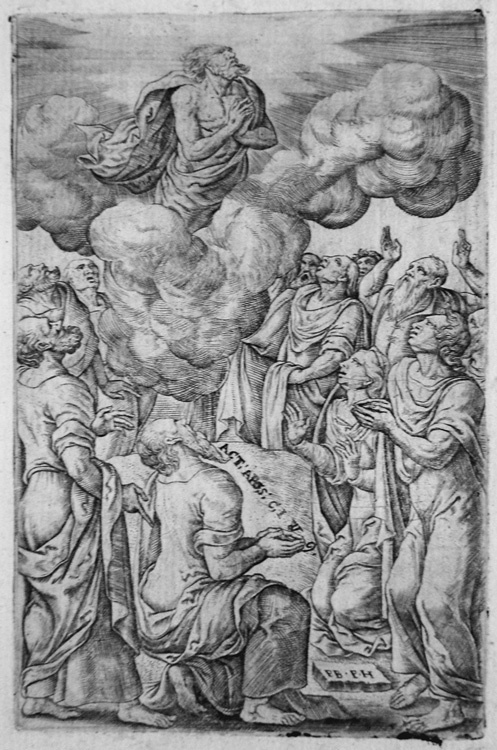 |
|
|
|
|
Pieter Huys (Antwerp, c. 1520-1577), The Ascension (Holl. 7-8) Engraving after Peter Van der Borcht II (1545-1608), c. 1570 for the Officium B. Virginis mariae (Antwerp, 1570, 1572, 1575) published by Christopher Plantin.A good impression on laid paper; on the verso is Jan Wierix's St. Luke. Signed PB PH on the rock lower right with the Biblical reference "Act: Apos: c. 1 vv 9" added just above St. Peter's hands. The presence of the engraving by Jan Wierix on the verso suggests that his may have come from a collection of engravings available printed for salesmen for the Plantin-Moretus printing house in Antwerp. Image size: 111x74mm. Price: Please call or email for current pricing information.
|
|
|
|
|
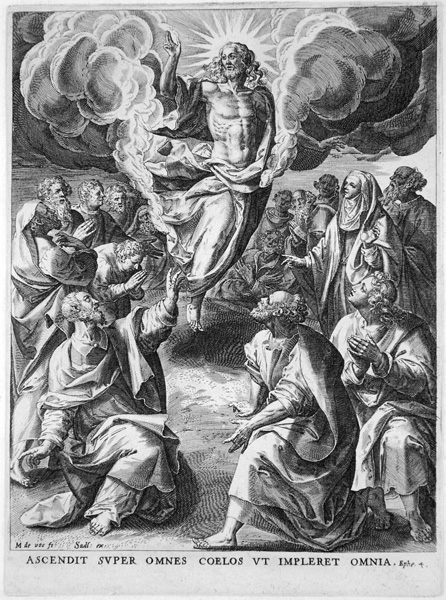 |
|
Jan Sadeler (Flemish, 1550-1600), The Ascension (New Hollstein de Vos 418 i, TIB 7004: 104). Engraving after a lost drawing by Maarten de Vos, 1579-1582. A very good impression on laid paper of the first state with large margins. Executed for The Mysteries of the Rosary. Signed lower right: "M de Vos fi / Sadl: ex." Isabelle de Ramaix (in TIB 7004, p. 123) says "They are likely to have been engraved by Johan I and Raphael I Sadeler under Johan I's supervision." Image size: 195x147mm. Price: Please call or email for current pricing information.
|
|
|
|
|
|
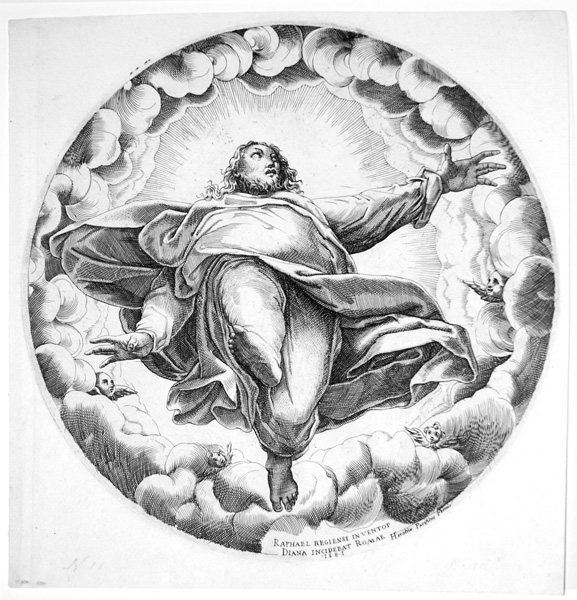 |
|
|
Diana Scultori (Mantua, before 1542-1612, Rome) The Ascension (B. 11), engraving after Raffaellino da Reggio, 1581. Inscribed "Raphael Regieni Inventor. Diana incidebat Romae 1581." Our impression published in the 17th century by Orazio Pacifico. Old collection number (N. 11) written lower left. Image size: 232mm in diameter. Price: Please call or email for current pricing information.
|
|
|
|
|
Spaightwood Galleries, Inc.
To purchase, call us at 1-800-809-3343 (1-508-529-2511 in Upton MA & vicinity) or send an email to spaightwood@gmail.com.
We accept AmericanExpress, DiscoverCard, MasterCard, and Visa.
We also accept wire transfers and paypal.
For directions and visiting information, please call. We are, of course, always available over the web and by telephone (see above for contact information). Click the following for links to past shows and artists. For a visual tour of the gallery, please click here. For information about Andy Weiner and Sonja Hansard-Weiner, please click here. For a list of special offers currently available, see Specials.
All works are sold with an unconditional guarantee of authenticity (as described in our website listing).
Copyright 2004-2017, Spaightwood Galleries, Inc.
Go back to the top of this page.
Visiting hours: Saturday 10:00 am to 5:00 pm and Sunday noon to 6:00 pm and other times by arrangement.
Please call to confirm your visit. Browsers and guests are welcome.
|
|
|
|
|
|
|
|
|
|
|
|
|
|
|
|
|
|
|
|
|
|
|
|
|
|
|
|
|
|
|
|
|
|
|
|
|
|
|
|
|
|
|
|
|
|
|
|
|
|
|
|
|
|














